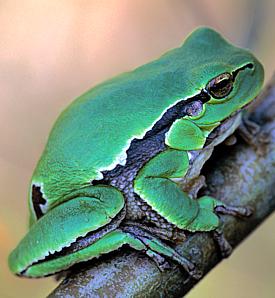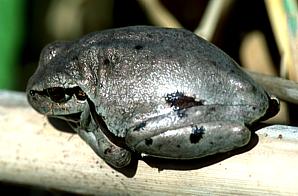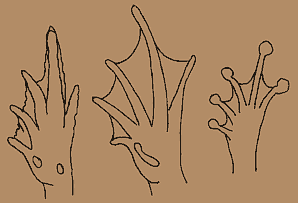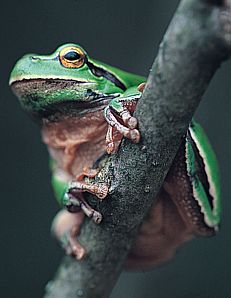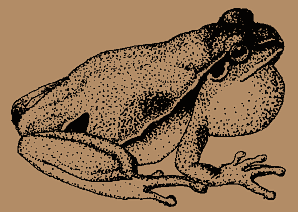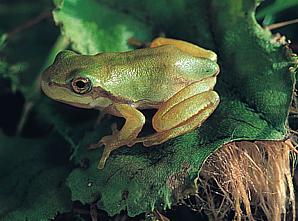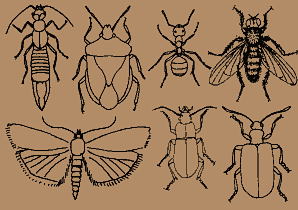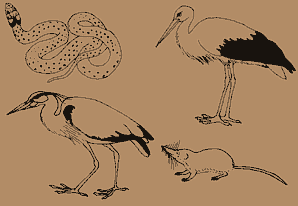|
AMPHIBIANS
|
|||||||||||||||
Text:
|
Tree frog
COMMON TREE FROG Hyla arborea is present in Europe (except for Great Britain, Ireland and the Scandinavian Peninsula apart from Sweden), in Asia Minor and in northern Africa. In Poland, it is observed in the area of the whole country except for mountains. During the period of land life, it lives among trees and bushes, in deciduous and mixed forests, shrubberies, parks, bushes, orchards and gardens but also in meadows. During the mating season, it moves to water reservoirs with shores covered with vegetation, rich in water plants. It is the most stenothermal species of all our national amphibians; it exhibits diurnal and crepuscular activity. It is quite scarce in the area of the Wigry National Park because it breeds only in several smallish water reservoirs in the vicinity of the villages of Krzywe and Sobolewo.
A common tree frog is a very delicate and smallish amphibian, with a smooth and shining skin. Males reach the length of approximately 3-4 centimetres while females can reach the length of even 6 centimetres. Pigmentation of a common tree frog is a typical protective pigmentation, which can additionally change depending on the colour of the ground. The dorsal part of the body is prevailingly green, however it can adopt the following colours: tallow, grey, bluish, lilac and brown. Change of colour of the body of the common tree frog may be caused by a sudden and abrupt alternation of the external conditions, hunger and pain. The ventral part of the body is usually white or creamy-white and there are contrasting black and white stripes running along the sides of the body.
One of characteristic features of the common tree frog is the presence of cushion-like, rounded pads which make it easier to remain on smooth surfaces. A common tree frog is the only European species of amphibians, which exhibits the arboreal way of life.
The common tree frog wakes up from winter hibernation very late - at the end of March or at the beginning of April. The mating season lasts from the end of April till June and only during the night. Males - with the aid of a single, large resonator placed directly at the bottom of the oral cavity - utter choral, rhythmical sounds which happen to be the loudest sounds uttered by amphibians at all.
The presence of the sound bag is the only feature distinguishing a male from a female. Males also lack mating calluses (pachynses on toes of the front limbs), which are typical for males of other tailless amphibians. Males have significantly darker dewlap, thanks to this fact it is possible to distinguish males and females even after their mating season.
The intensity of sound depends on temperature of water to a large extent - in warmer water males "sing" much louder. Males of a common tree frog also utter sounds beyond their mating season during the land period of their lives, however, these sounds are absolutely different from mating calls.
The amplexus (that is coupling of a male and a female) is very ephemeral. A female spawns the frogspawn in small portions, in the form of small clusters attached to shoots of water plants. There are approximately from 20 to 150 eggs in such a cluster. An egg is light-brown on side and light-yellow on the other side.
The development cycle for the larva lasts for approximately 3 months. At first, tadpoles attach themselves to water plants with the use of the pad while more mature forms of these swim freely. Before transformation, they usually reach the length ranging from 46 to 49 millimetres. After the transformation, young tree frogs leave their water reservoir. Sexual maturity is reached after 2 years. They hibernate from the end of September or from the beginning of October. They hibernate only on land, under the layer of fallen leaves or in various land cracks.
Nourishment of a common tree frog consists mostly of insects and spiders, which are caught by a sudden throw of a long, sticky tongue. It also eats earwigs, heteropters, ants, cockchafers, dipteras, butterflies and snails but in smaller quantities. It spends most of its time hiding among leaves, waiting for its prey but it is also capable of jumping from leaves, so as to catch the insect in flight. Tree frogs avoid wasps and all other insects, which resemble them with their outer appearance.
A common tree frog is a very titbit for all predatory animals; however, its alternating pigmentation provides it with a perfect protection. The main natural foes of this species include the following: grass snakes and various species of birds and mammals.
The basic form of protection of a tree frogs is linked with protection of its reproduction places - smallish water reservoirs which are overgrown with rich rush vegetation. There is only one small isolated population of this species in the area of the Wigry National Park. There is also its north-east border of its occurrence in the vicinity of the Park. It is necessary to undertake active forms of protection in order to keep tree frogs in the park; active protection in this context means recreation of its reproduction places.
In the past, tree frogs were bred very willingly because it was believed that they are capable of foretelling the whether. They were placed in a glass jar with a small ladder inside. If the common tree frog climbed to the top of the ladder, it would mean that the weather was supposed to worsen. Today it is known that is was just a superstition. Moreover, breeding tree frogs, just like all other protected animals, is against the law.
|
||||||||||||||
|
|
|
